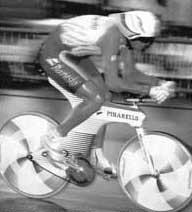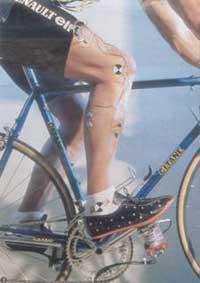Stand by bike and quiet
2000/10/15 Kortabarria Olabarria, Beñardo - Elhuyar Zientzia
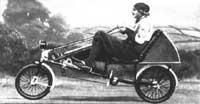
Bicycles, similar to those currently existing. They are the invention of the late twentieth century. The antecedents are very previous, as in the drawings of Leonardo Da Vinci one sees an artiluge propelled by chain. Da Vinci's never went from drawing.
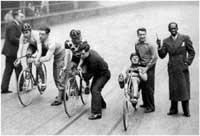
XV. and XVIII. Although several carts without horses were invented between the 3rd and 17th centuries, there was no revolution. That year a German engineer invented a two-wheel artiluge of wood powered by man. The invention of Baron Ludwing von Drais, unlike the gadgets that existed until then, had a seat and seat, which is why it was revolutionary. In 1838 the Scottish Mc Millan gave a new jump to the pedal bike (and therefore to the traction). Frenchman Michaux improved the invention by placing the pedals on the front wheel. Then the design of the bikes was modified and began to see bicycles with large front wheel and small rear. Speed became an obsession because the bikes were very slow. Every time he pedalled, they advanced about three meters. With logic, the bicycle builders began to build bigger and bigger front wheels, but not only did the difficulties increase to maintain balance, but the bikes acquired overweight. So, once again, they started making bicycles with smaller wheels. In all this history, the year 1888 was important, after having invented tires that could be inflated to replace the wooden and rubber wheels. Little time in France the Michelin brothers and in Italy Pirelli pulled out a tire that could be mounted and dismantled, so with some cameras and a little humor had to go anywhere, although in XX. Bicycles of the early twentieth century weigh about 20 kilos. In the 1920s the variator was invented, which also represented a great advance.
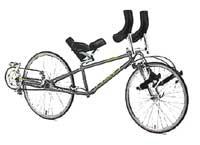
Since then, to date, there have been no significant changes, although bicycles are becoming lighter and more suitable from the aerodynamic point of view. Perhaps, to mention some, we should remember the appearance of the mountain bike and the invention of the automatic variators. Thanks to all these advances, bicycles have achieved great success and social recognition, but not all bicycle concepts, such as isolated bicycles, are so successful. And that's rare, because they have many characteristics to be a prosperous future.
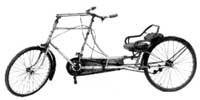
Although it seems the opposite, the design of isolated bicycles is not new. XIX. Invented for the twentieth century, at the beginning of the century, large bicycle builders, like Peugeot, also did in production lines. For many years the conventional and isolated bicycle industry grew together until in 1933 the cyclist Francis Faure broke the record back then. French cyclist Francis Faure was not (he was not even given water) one of the best in the platoon. However, Faure was able to break the record of that time that no one could overcome since 1913. The record was 44 kilometers and 247 meters, and Faur toured 45 kilometers and 55 meters. That same year it passed records of 5, 10, 20, 30, 40 and 50 kilometers.
Perhaps someone could associate the feat with the sudden recovery of the French cyclist, but the key was not to be in the leg strength of Francis Faure, but carried it under the ass. In fact, Francis Faure used the bicycle lying down to break all records. However, at 6 months after the implementation of the new records, the ICU left them bankrupt. Faur decided that the used bicycle was not legal and established the minimum distances between the saddle, pedalier and fork. The decision of the ICU discarded the isolated bicycles.
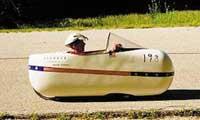
What would have happened if there was no prohibition? It is hard to imagine what might happen, but not to explain what has happened. For many years (about 40) the design and industry of the isolated bicycles has been paralyzed, without progressing. In one of these cases, at the end of the 70's, interest was raised for the isolated bicycles, so they left the black hole that were parked. The road started in the last decade was strengthened in the 80s and 90s and there are already brands that manufacture other bicycles such as Bavatus or Trek that have started to market isolated bicycles. Here they are still not seen, but where the culture of the bicycle is more widespread, as in Holland, they are becoming usual.

So far, although they have been considered second-class, the future can be that of bicycles lying down. Because of their design, they are faster than conventional bikes. The only information to realize is that the current record of bicycles is 79 kilometers and 136 meters, compared to the 56 kilometers and 375 meters that Chris Boardman made in 1996 with the conventional bicycle. Therefore, the difference is remarkable, and more if you consider that users of the conventional bicycle are professional (much more prepared). In addition to the speed at which you can get there, there are many other features to bet on in the future by isolated bikes:
- Comfort. The main advantage may be that the position on the bike is more natural.
- Better aerodynamics.
- Thanks to the help of the back, greater transmission of force to the pedals.
- Higher speed in the curves. This is because there is no danger that the pedal will touch ground, so you can also pedal the curves.
- Lower risk of falling as the center of gravity is lower.
They are not small advantages, but there are more. Perhaps the most noteworthy is the possibility of installing body to improve aerodynamics and protect it against bad weather. In Euskal Herria we would be very grateful!
Published in 7

Gai honi buruzko eduki gehiago
Elhuyarrek garatutako teknologia




